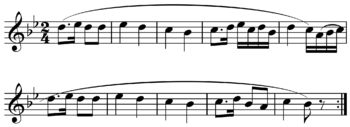
Back Музикален период Bulgarian Periode (musik) Danish Periode (Musik) German Periodo (muziko) Esperanto Periood (muusika) Estonian جمله (موسیقی) Persian Periódus (zene) Hungarian Պարբերություն (երաժշտություն) Armenian Periodo (musica) Italian პერიოდი (მუსიკა) Georgian


In music, the term period refers to certain types of recurrence in small-scale formal structure. In twentieth-century music scholarship, the term is usually used as defined by the Oxford Companion to Music: "a period consists of two phrases, antecedent and consequent, each of which begins with the same basic motif."[3] Earlier usage varied somewhat, but usually referred to similar notions of symmetry, recurrence, and closure. The concept of a musical period originates in comparisons between music structure and rhetoric at least as early as the 16th century.[4]
- ^ White, John D. (1976). The Analysis of Music, p. 44. ISBN 0-13-033233-X.
- ^ White (1976), p. 45.
- ^ Whittall, Arnold. "period." The Oxford Companion to Music. Oxford Music Online. Oxford University Press. Accessed August 4, 2015.
- ^ Ratner, Leonard G. "Period." Grove Music Online. Oxford Music Online. Oxford University Press. Accessed April 22, 2015.
© MMXXIII Rich X Search. We shall prevail. All rights reserved. Rich X Search